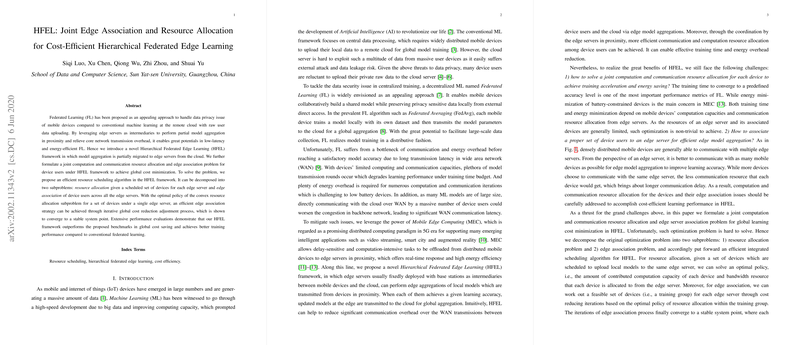An Overview of HFEL: Joint Edge Association and Resource Allocation for Cost-Efficient Hierarchical Federated Edge Learning
The paper "HFEL: Joint Edge Association and Resource Allocation for Cost-Efficient Hierarchical Federated Edge Learning" offers an insightful approach to addressing the challenges associated with Federated Learning (FL) in mobile environments. It introduces the Hierarchical Federated Edge Learning (HFEL) framework, which strategically employs edge servers to facilitate partial model aggregation, thereby optimizing both communication and computation resources.
Federated Learning and the Role of HFEL
Federated Learning has been recognized as an effective method for ensuring data privacy by avoiding raw data transfer to the cloud. Instead, it aggregates model updates from multiple devices. However, FL faces significant challenges in communication and energy efficiency, especially with the extensive WAN communications involved between devices and a centralized cloud server.
HFEL addresses these challenges by introducing intermediary edge servers positioned closer to the devices, which perform local aggregations of the model updates before forwarding them cloud-ward. This hierarchical aggregation strategy is intended to reduce WAN latency and energy consumption significantly, proving beneficial in scenarios where real-time edge computing becomes essential.
Methodology and Problem Formulation
The authors formulate a dual-layer optimization problem within the HFEL framework that integrates the allocation of computation and communication resources with the dynamic association of devices to edge servers. This optimization strives for a global minimization of costs associated with learning tasks, where costs are broadly defined in terms of energy consumption and operational latency.
To tackle the complex optimization problem, the authors propose a decomposition into two subproblems: resource allocation and edge association. These are addressed through iterative strategies designed to minimize costs effectively and ensure converging to a stable, efficient system throughput, thereby maximizing the use of available resources.
Performance Evaluation
The numerical evaluations depicted in the paper suggest that the HFEL framework outperforms traditional FL models, notably FedAvg, in both cost efficiency and learning performance. The framework achieved substantial reductions in global energy consumption and latency, validated across varying numbers of devices and edge servers, and under different data loading conditions.
The simulations reveal that HFEL provides better convergence performance in terms of test accuracy, training accuracy, and training loss, compared to legacy FL infrastructures. This is attributable to the framework's ability to localize computations and resource allocations partially at the edge layer, demonstrating lower communication overheads and improved model training efficiencies.
Implications and Future Directions
The HFEL framework's hierarchical approach offers promising improvements in edge-oriented federated learning systems by optimizing both resource usage and learning performance. By reducing dependency on centralized cloud computing and introducing flexible model aggregation at the edge, HFEL presents a scalable solution for the AI-driven advancements anticipated within the IoT and mobile computing domains.
Future work could delve into adaptive strategies for dynamically optimizing the resource allocation and edge association in real-time, considering fluctuating network conditions and device mobility. Additionally, exploring privacy-preserving aggregation techniques in the hierarchical setting could strengthen the model's usability across more privacy-sensitive applications.
In conclusion, the HFEL framework marks a significant enhancement over existing federated learning models by tactfully leveraging edge computing potentials to optimize resource allocation and cost efficiency, particularly relevant for contemporary and future AI-powered edge applications.
